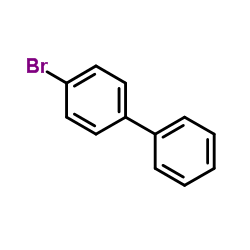4-Bromobiphenyl

4-Bromobiphenyl structure
|
Common Name | 4-Bromobiphenyl | ||
|---|---|---|---|---|
| CAS Number | 92-66-0 | Molecular Weight | 233.104 | |
| Density | 0.9327 | Boiling Point | 310 ºC | |
| Molecular Formula | C12H9Br | Melting Point | 89-92 ºC | |
| MSDS | Chinese USA | Flash Point | 143 ºC | |
| Symbol |



GHS05, GHS07, GHS09 |
Signal Word | Danger | |
|
Update on biological actions of 1alpha,25(OH)2-vitamin D3 (rapid effects) and 24R,25(OH)2-vitamin D3.
Biochem. Pharmacol. 31(10) , 1849-56, (1982) All biologic responses to vitamin D are now known to arise as a consequence of the metabolism of this seco-steroid into its two principal biologically active metabolites 1alpha,25(OH)(2)-vitamin D(3) (1ALPHA;,25(OH)(2)D(3)) and 24R,25(OH)(2)-vitamin D(3) (24R... |
|
|
A Taiji-principle-designed magnetic porous C-doped graphitic carbon nitride for environment-friendly solid phase extraction of pollutants from water samples.
J. Chromatogr. A. 1412 , 12-21, (2015) A new magnetic porous carbon-doped graphitic carbon nitride nanocomposite and experimental strategies were environment-friendly designed for solid phase extraction of brominated flame retardants from water sample. The easily synthesized and low cost nanocompo... |
|
|
Halopicolinic acids, novel products arising through the degradation of chloro- and bromo-biphenyl by Sphingomonas paucimobilis BPSI-3.
Can. J. Microbiol. 42(1) , 66-71, (1996) Sphingomonas paucimobilis BPSI-3 was previously isolated from a mixed microbial consortium growing on biphenyl as the sole source of carbon and energy. Transformation of 4-chlorobiphenyl (4CBP) was demonstrated by this strain, although little or no growth was... |
|
|
Electrocatalytic reactions in organized assemblies: Part I. Reduction of 4-bromobiphenyl in cationic and non-ionic micelles. Rusling JF, et al.
J. Electroanal. Chem. Interfac. Electrochem. 240(1) , 201-16, (1988)
|
|
|
Structure of 4-biphenylthiolate on Au nanoparticle surfaces studied by UV-Vis absorption spectroscopy, transmission electron microscopy and surface-enhanced Raman scattering. Jang S, et al.
Surf. Interface Anal. 36(1) , 43-48, (2004)
|